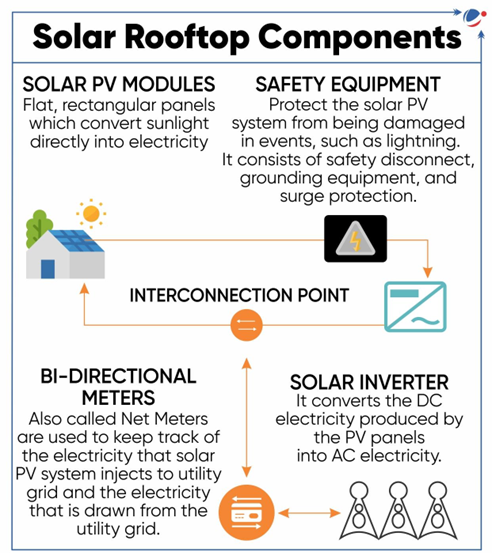Why in the news?
Recently, Union Cabinet has approved - PM Surya Ghar Muft Bijli Yojana for installing Rooftop Solar in one crore households nationwide.
About PM Surya Ghar Muft Bijli Yojana
- Key Highlights of Scheme
- Ministry: Ministry of New & Renewable Energy.
- Aim: To provide free electricity up to 300 units every month for one crore households.
- Subsidy structure: Central Financial Assistance for Residential Rooftop Solar (RTS) up to:
Suitable Rooftop Solar Plant Capacity | Subsidy Support |
| 1 – 2 kW | Rs 30,000 to Rs 60,000/- |
2 – 3 kW | Rs 60,000 to Rs 78,000/- |
Above 3 kW | Rs 78,000/- |
- Loan for installation of residential RTS: Households can access collateral-free low-interest loan products of around 7% for installation of RTS systems up to 3 kW.
- Other features of the scheme
- Model Solar Village: It will be developed in each district of country to act as a role model for adoption of rooftop solar in rural areas.
- Incentives to Local Bodies: Incentives for Urban Local Bodies and Panchayati Raj Institutions for promoting RTS installations in their areas.
- National Portal: It will facilitate household to apply for subsidies and select a suitable vendor for installing rooftop solar.
- Component for payment security for Renewable Energy Service Company (RESCO) based models as well as a fund for innovative projects in RTS.
- Significance of PM Surya Ghar Muft Bijli Yojana:
- Savings: 1 crore families will save Rs 15000 crore annually through reduced electricity bills.
- Income Generation: Households can earn income by selling surplus power to electricity Distribution Companies of their area.
- Expansion of Solar Capacity: Scheme will result in addition of 30 GW of solar capacity through RTS in residential sector.
- Job creation: Scheme will enable more EV charging and create entrepreneurship opportunities for a large number of vendors.
- Significant reduction in carbon emissions: Reduction of nearly 720 million tonnes of CO2 equivalent emissions.
- Fosters India’s goal of becoming self-reliant in energy sector.
Other Initiatives to Promote Solar Energy
|
About Solar Rooftop System
- Rooftop solar panels are the photovoltaic panels installed on the roof of a building which is connected to the main power supply unit.
- A solar rooftop system typically consists of solar modules, solar inverter(s) and other electrical components like meter(s), cables etc.
- Solar rooftop panels capture the energy from sunlight and convert it into usable electrical energy.
- India’s Current Rooftop Solar Capacity
- Currently, India has installed 11 GW of rooftop solar capacity, of which 2.7 GW is in the residential sector.
- Gujarat is the leader in Rooftop Solar installations (82%) in the country, followed by Maharashtra and Rajasthan.

Challenges for scaling up Solar Rooftop System
- Grid integration: Grid stability, and energy storage due to variability and unpredictability of solar energy.
- For example, climatic factors (temperature and solar irradiation) directly affect solar power generation.
- High cost: Lack of Research & Development, modern development facilities, and manufacturing infrastructure impact the development of solar panels, equipment, and inverters. This further leads to increased imports from other countries, thereby increasing the cost of the system.
- Low DISCOMs participation: Rooftop solar systems reduce the bill generated by high-paying consumers for the DISCOMs; hence, their participation in promoting the system is low.
- Low net metering: Poor and piecemeal implementation of net metering policies at the sub-national scale is a major roadblock to the uptake of rooftop solar in India.
- Net metering is an arrangement under which rooftop solar PV system installed at consumer premises delivers surplus electricity, if any to the distribution licensee.
- Lack of awareness: There is a general information asymmetry and, lack of knowledge about specific products, processes, and approval systems inherent with solar rooftop systems.
Way forward
- Time-bound approval and commissioning processes for deployment of solar rooftop.
- Third-party inspectors from reputed, empanelled, and inspection agencies to address grid integration challenges.
- Improving Grid Infrastructure by increasing grid availability and quality in semi-urban and rural areas, especially during peak sunshine hours.
- Modifying the net metering policies and removal of capacity constraints.
- Single-window facility for the entire ecosystem of rooftop PV deployment.



